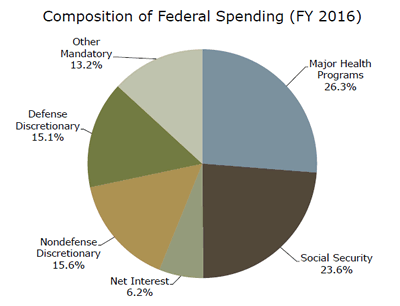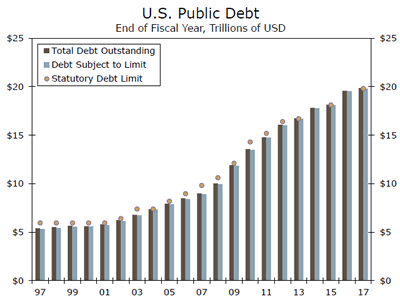U.S. Review
The Economic Narrative Carries into Q2
- The ISM manufacturing index dipped in April but remained firmly in expansionary territory, while its services counterpart rose to a solid 57.8 reading.
- At the conclusion of the FOMC’s May meeting, the committee chose not to raise the fed funds rate. Language in the policy statement, however, signaled that the Fed views the Q1 economic slowdown as transitory, potentially teeing up a rate hike in June.
- Employers added 211,000 new jobs in April, topping expectations. Both the U-3 and U-6 unemployment rates fell to cycle-lows, but wage growth was slower than expected.
The Economic Narrative Carries into Q2
Economic data released this week contained some of the first information available for Q2. To kick off the quarter, the ISM manufacturing index showed factory sector activity had cooled a bit in April. The reading of 54.8 was the third consecutive decline and was lower than consensus. At 54.8, however, the index remains firmly in expansion territory and signals a clear improvement relative to the past couple years (top chart). The multi-year high of 57.7 reached in February would be consistent with a much-stronger rate of growth than we have been forecasting, so the return to a more sustainable pace of expansion suggested in this report for April is consistent with our forecast.
On Wednesday, the ISM’s service sector counterpart topped expectations, rebounding to 57.8. The new orders index climbed 4.3 points to post its current cycle-high of 63.2. Demand was boosted by better global economic conditions, as new export orders jumped 3 points to 65.5, just a half point below the alltime high for the series. Taken together, the underlying trend for these two indicators suggest that the slowdown in economic growth in Q1 was transitory and a rebound in Q2 is in the offing.
Labor productivity data were also released this week. Over the long-run, economic growth is driven by two factors: the growth in the labor force, and the growth in the productive capacity of these workers. As illustrated in the middle chart, labor productivity growth has been persistently slow in recent years. The data for Q1-2017 largely reinforced this narrative. Nonfarm productivity declined at a 0.6 percent annualized rate in Q1. The year-overyear pace remained steady at 1.1 percent. Amid slow productivity growth and an aging population, achieving sustainable economic growth faster than 2-2.5 percent a year will be challenging.
Against this backdrop, the Fed refrained from raising the fed funds rate at its May meeting. Similar to our view, the Fed’s policy statement reinforced the belief that the slowdown in economic growth in Q1 was transitory. In addition, the Fed tweaked its view on inflation, choosing to focus on the recent 12-month change in various inflation measures rather than the performance over recent quarters, as was done following the March meeting. Both the headline and core PCE deflators ticked down on a year-ago basis in March, but at 1.8 percent and 1.6 percent respectively, inflation remains close to the two percent target. The bottom line is the Fed still sees economic activity, the labor market and inflation on course with its expectations, which positions the Fed to raise the fed funds rate in June.
Finally, the employment report this morning showed 211,000 new jobs were added in April. Job gains were generally broadbased, and both the U-3 and U-6 unemployment rates fell to new cycle-lows. Furthermore, despite a slight decline in the total labor force participation rate, the participation rate for prime-age workers actually rose in April, keeping a broader upward trend intact (bottom chart). However, wage growth disappointed relative to consensus. On balance, today’s report is supportive of a June rate hike, but the tepid acceleration in wages will likely reinforce the Fed’s cautious approach to tightening policy.
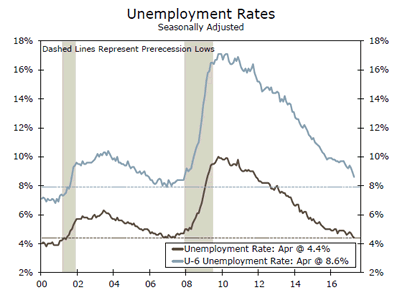
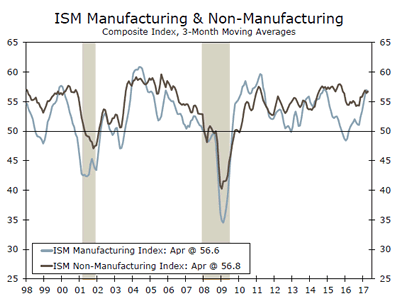
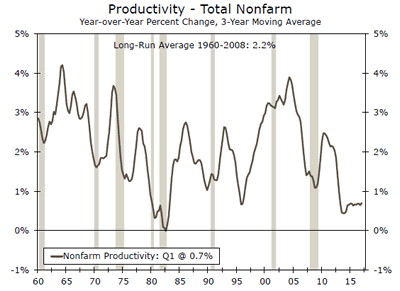
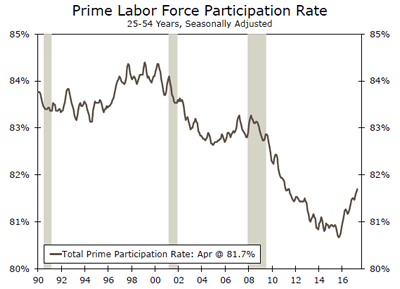
U.S. Outlook
Import Prices • Wednesday
Lower prices for imported energy weighed on headline import prices in March, which declined 0.2 percent from February. March was the first decline in four months as the recovery in oil prices slowed. Excluding petroleum, import prices rose 0.2 percent on the month amid strengthening in the business sector, with rebounds in industrial supplies and capital goods driving the nonfuel import price recovery. Revisions to earlier data revealed some easing in the rate of goods deflation in the CPI may be in the offing. Exporters continue to benefit from improved global demand and a more stable dollar allowing further export price increases. Export prices increased in March at the strongest year-over-year pace since 2012. We expect headline import prices declined again in April on continued softness in petroleum prices.
Previous: -0.2% Wells Fargo: -0.1% Consensus: 0.2%
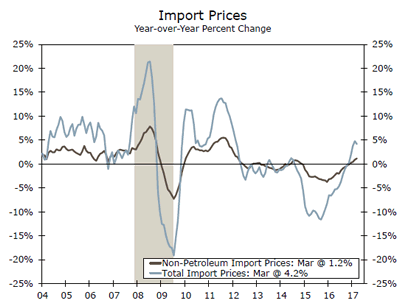
CPI • Friday
Gasoline prices played a large role in March’s 0.3 percent decline in the headline CPI. That said, the core CPI also unexpectedly declined in March as consumers paid less for wireless telephone services on the month. Shelter and medical inflation also eased in March, which usually provide a greater lift to core services prices. Core goods declined 0.3 percent on softer apparel and transportation prices. The decline in apparel prices looked to be payback from early outsized gains, but softness in transportation goods prices is unlikely to abate, particularly as the glut of used vehicles coming off lease this year weighs on vehicle prices.
We expect both the core and headline CPI to rise 0.2 percent in April as much of the softness in March could be attributed to oneoff factors, such as the drag from the unusually large decline in wireless services on core services inflation.
Previous: -0.3% Wells Fargo: 0.2% Consensus: 0.3%
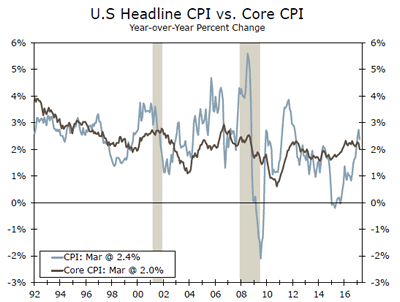
Retail Sales • Friday
We expect retail sales bounced back in April after a disappointing start to the year. Retail sales declined 0.2 percent in March after falling 0.3 percent in February. The declines were largely due to the auto sector, as retail sales ex auto were flat both months. Sales were also likely affected by unusual weather patterns affecting the timing of purchases at home and garden stores. Gasoline stations and food and drinking places also saw sales decline in March.
Control group sales, used to calculate GDP, were volatile in recent months, and we know from the first look at Q1 GDP that personal consumption did indeed soften in the first three months of the year. That said, underlying fundamentals support our call for a rebound in coming month due to the strong job market and income gains. However, we doubt the auto sector will be as supportive as in recent years as sales likely hit its peak in 2016.
Previous: -0.2% Wells Fargo: 0.5% Consensus: 0.6%
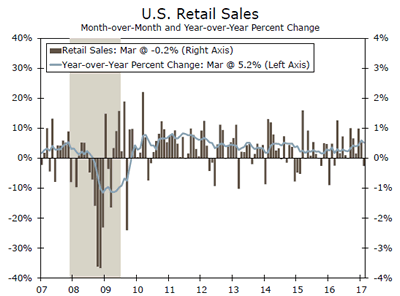
Global Review
Mixed Data on the Global Economy
- We received mixed data from the global economy in April with the Caixin China manufacturing PMI coming in at a lower level than expected, 50.3, versus expectations of 51.3 and lower than the previous month.
- Meanwhile, Eurozone GDP expanded at a 0.5 percent clip, not annualized (which represents a 1.8 percent annualized rate), in the first quarter of the year and in line with consensus expectations. On a year-earlier basis, real GDP was up 1.7 percent.
- The Brazilian industrial production index for March also disappointed when it stumbled 1.8 percent versus February, seasonally adjusted.
Mixed Data on the Global Economy.
We received mixed data from the global economy in April with the Caixin China manufacturing PMI coming in at a lower level than expected, 50.3, versus expectations of 51.3 and lower than the previous month. The lower reading was disappointing at the start of the second quarter. Furthermore, the services PMI was also lower than the March reading, down to 51.5 versus 52.2 in March. That is, this first reading from the manufacturing and service sectors from the second largest economy in the world does not bode well for overall economic growth. Having said this, both indices remained in expansion territory even though the manufacturing index was very close to the 50 demarcation line.
Meanwhile, the Eurozone expanded at a 0.5 percent clip, not annualized (which represents a 1.8 percent annualized rate), in the first quarter of the year and in line with consensus expectations. On a year-earlier basis real GDP was up 1.7 percent. Thus, growth in the Eurozone agreed with expectations and has remained relatively stable recently, which is good for overall global economic growth but not a growth rate that could set off stronger economic growth across the global economy.
At the same time, markets were celebrating the fact that all the political pundits gave Emmanuel Macron an edge over Marine LePen during the first and only French presidential debate ahead of this weekend second round presidential elections. Thus, today, markets are betting that Mr. Macron will be elected president of France and the European Union will probably breathe a sigh of relief as Mr. Macron supports France’s continuity in the European Union and in the euro area. Furthermore, if Mr. Macron wins, the country will prevent an extreme rightist party from taking over the presidency in the second largest country in the Eurozone.
Meanwhile, in this hemisphere, the Brazilian industrial production index for March disappointed when it stumbled 1.8 percent versus February, seasonally adjusted. On the positive side, industrial production still managed to increase 1.1 percent versus a year earlier and non-seasonally adjusted. However, this year-over-year comparison is not a very good gauge of the conditions of the sector because it is comparing a full month of industrial production this year with March of last year, which was shorter because of Easter week. At the same time, manufacturing production was also very weak, down 1.7 percent versus February and up only 0.2 percent compared to March of last year.
In Mexico, gross fixed investment in February disappointed once again, coming in lower by 0.8 percent after falling 1.8 percent in January, both seasonally adjusted. On a year-over-year comparison, gross fixed investment in Mexico dropped 3.1 percent, the largest decline since June of last year. Thus, if the better than expected flash result for first quarter GDP is confirmed later this month it will mean that other components of GDP must have been very strong and/or that gross fixed investment recovered strongly in March to close the quarter.
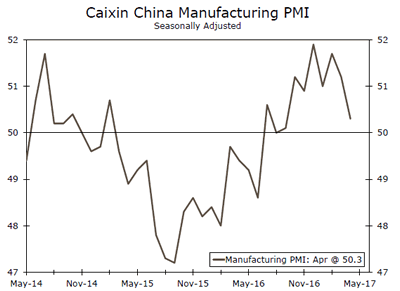
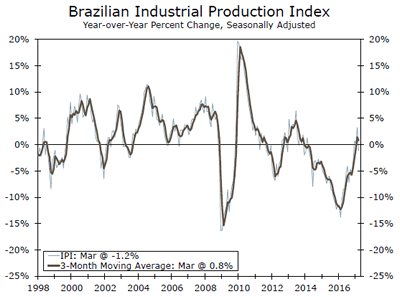
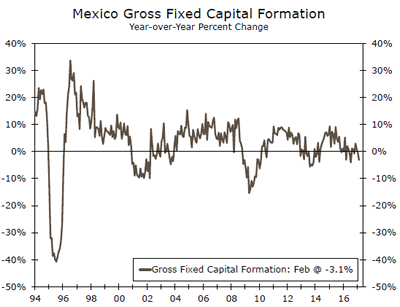
Global Outlook
Canada Housing Starts • Monday
Canadian housing starts raced ahead of market expectations of a 215,000-unit increase in March and instead jumped over 18 percent over the month to a 253,200-unit pace. March’s starts marked the highest level since September 2007, with much of the increase coming from multifamily homes and condominiums in urban areas, which rose 30.2 percent to a 160,989-unit pace. Single-family homes, on the other hand, rose by a more moderate 3.1 percent to a 74,685-unit pace. Housing has been a main driver in Canada’s economy over the past several years due to historically low interest rates and larger metros, such as Toronto and Ottawa, seeing their housing markets heat up. That said, consensus is expecting some payback from March’s surge, and looks for starts to have come back down to a more modest 220,000-unit pace in April.
Previous: 253,200 Consensus: 220,000
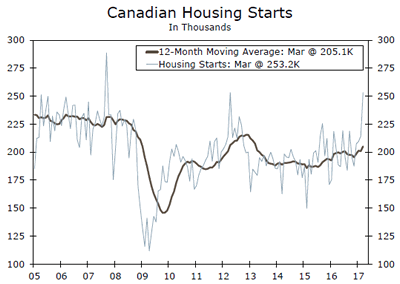
U.K. Bank of England Rate • Thursday
Economic growth in the U.K. downshifted in Q1, weighed down by softening in the service sector which suggests that consumer spending started the year on a weaker note. In addition, CPI inflation has started to pick up, helped by the rebound in energy prices, and core CPI has moved higher as well. The jump in prices has started to eroded real income growth and reduced growth in consumer spending, which we expect to remain a headwind for the U.K. economy.
At the Bank of England’s meeting next week, we look for the Monetary Policy Committee (MPC) to keep its bank rate unchanged at 0.25 percent and remain on hold through 2017 due to the slowing growth and rising inflationary pressures the economy is facing. Although shifting inflation dynamics could cause some of the MPC members to sanction a rate hike sooner rather than later, the current accommodative stance will likely remain in place.
Previous: 0.250% Wells Fargo: 0.250% Consensus: 0.250%
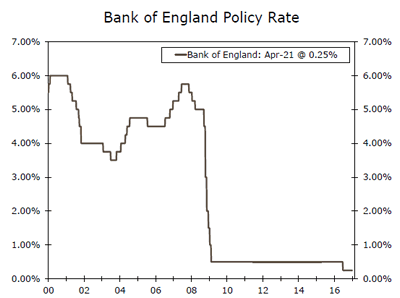
Mexican Industrial Production • Friday
Mexican industrial production (IP) increased 0.1 percent on a monthly basis in February as mining output weighed on overall growth. Construction activity rebounded over the month, rising 0.9 percent and rose an even stronger 3.0 percent year over year. Meanwhile, the mining sector has declined even further, falling 13.7 percent on a year-ago basis. Conversely, growth in the manufacturing industry remained relatively stable at 1.1 percent. Mexico’s preliminary Q1 GDP, which printed earlier this week, showed that the secondary sector (includes industrial production) contracted 1.3 percent on a year-ago basis.
Other data on the docket next week include consumer price inflation, which has been running hot lately, rising to 5.4 percent year over year. Markets look for it to rise to 5.8 percent in April.
Previous: -1.7%
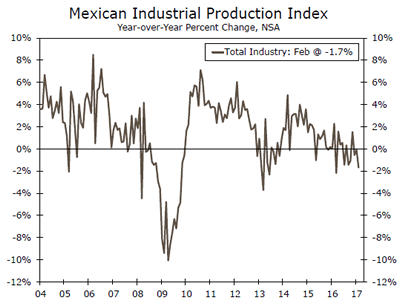
Point of View
Interest Rate Watch
Looking Past the First Quarter
The Federal Reserve went out of its way to downplay the slowdown in first quarter real GDP growth, stressing that the rate of growth has slowed rather than economic activity had slowed. Their policy bias remains toward gradually nudging interest rates higher and the financial markets are currently assigning a better than 90 percent probability that the Fed hikes the federal funds rate by a quarter point at the June 13-14 FOMC meeting.
The policy statement from the May meeting contained few surprises. The explanation of current economic conditions essentially stressed that the labor market is continuing to improve solidly and that business investment had firmed. The statement did note that household spending had increased "only modestly’ but went on to say that the underlying fundamentals supporting consumer spending remained solid. The bottom line is that Fed will continue to tighten as long as employment conditions remain strong.
The April employment numbers were right in line with the Fed’s expectations. Not only did nonfarm employment bounce back, as was expected, but the unemployment rate also fell to 4.4 percent. Job gains were fairly broad based and aggregate hours worked rose by a solid 0.5 percent, suggesting that real GDP will also bounce back in the second quarter.
The drop in the unemployment rate to 4.4 percent may set off concerns that the Fed will accelerate efforts to normalize interest rates. Right now, such a move would be premature. While the unemployment rate has surprised to the downside, wage and salary gains show very little sign of strengthening.
One possible explanation for the lack of wage growth is that the labor force participation rate for prime-working age persons is still well below its historic norms. This may be changing. There has been a notable acceleration in hiring in full-time positions and slowing in part-time jobs. This shift has coincided with an increase in household formations and home ownership. The Fed may not want to stomp this out just as it is getting started.
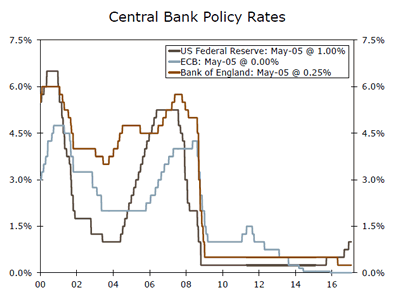
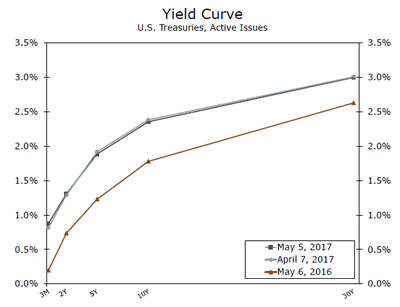
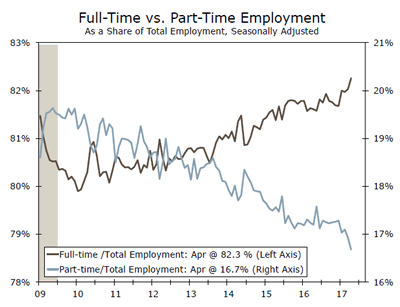
Credit Market Insights
Mortgage Credit & Rates Hold Steady
Mortgage credit availability was relatively unchanged in April, according to recently released data from the Mortgage Bankers Association’s Mortgage Credit Availability Index (MCAI). After rising to a fresh cyclehigh in March, the MCAI fell a slight 0.2 percent to 183 in April. A decrease in the MCAI indicates that lending standards are tightening, while an increase signals they are loosening. Despite the modest dip, the indicator of mortgage credit access remains on an upward trend and has generally risen since hitting a bottom in 2011. That said, on a historical basis, mortgages are still relatively difficult to obtain. While stricter lending conditions have diminished default rates, the mortgage market’s tight credit box has proved to be a headwind to the current cycle’s housing recovery.
Meanwhile, mortgage rates—another measure pertaining to borrowers’ ability to purchase a home—held fairly steady this week. According to Freddie Mac, the 30-year conventional fixed mortgage rate edged down a slight 0.1 percentage point to 4.02 percent during the week ending May 4. The 30-year mortgage rate has been trendless near 4 percent for the past four weeks. Against the backdrop of anticipated Fed tightening, we expect a modestly higher interest rate environment in the near-term. That said, we expect housing demand to trump the modest increase in interest rates, and look for home sales to continue to trend higher over the course of the year.
Topic of the Week
Shutdown Showdown Ends Quietly
Legislators agreed this week to a budget deal that funds the government through the end of fiscal year (FY) 2017, which ends Sept. 30. The agreement is largely devoid of the more controversial policy proposals that had the potential to derail the bill. Deep cuts to nondefense discretionary spending were avoided, and no funds were appropriated for a border wall. Defense spending received a $15 billion boost, although this was a smaller increase than what the White House had requested.
However, with the current fiscal year already more than halfway complete, policymakers will need to revisit this issue in the near future. In just five months, policymakers will once again need a plan to fund the government for FY 2018. Furthermore, the debt ceiling has the potential to add another wrinkle to the next round of negotiations. The spending bill agreed to this week does not increase the debt ceiling, which was reestablished on March 15. For the time being, this is not a major problem as the Treasury has the capacity to take "extraordinary measures" to remain solvent through the fall. A better understanding of how long the Treasury can operate under these circumstances will become clearer as spring tax collection data become available. The timeline suggests that this fall policymakers will face the dual challenge of passing a budget and raising the debt ceiling, a challenging lift during a period when legislators hope to be in the middle of a tax code rewrite.
In addition, legislators also revived their efforts to repeal elements of the Affordable Care Act (ACA). The passage of the ACA repeal bill is a significant accomplishment for Republicans, but it is important to remember that this is just one bar among several more that must be hurdled. The bill now heads to the Senate, where its fate is far from clear and Republicans hold just a two seat majority. If the Senate manages to successfully craft its own version, a conference committee between the two chambers would then have to hash out the differences. The more time spent on an ACA repeal bill, the less legislative calendar time will be free to tackle tax reform.
